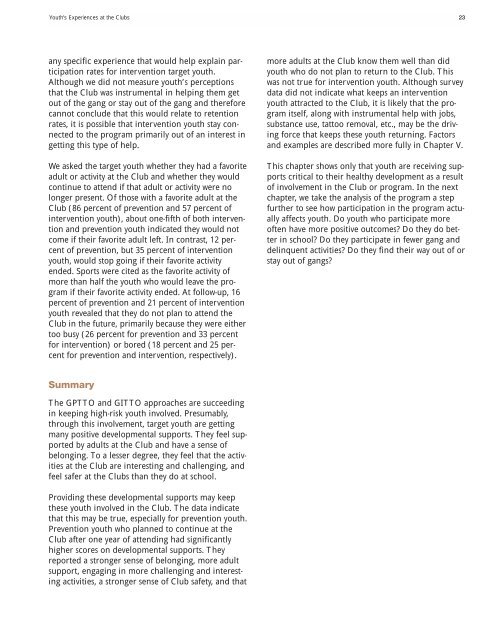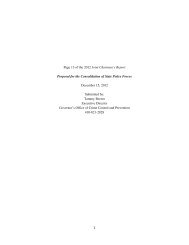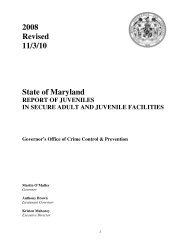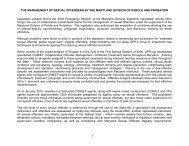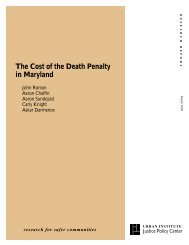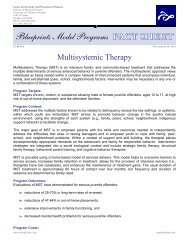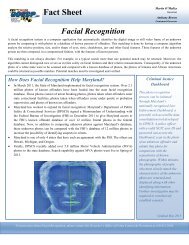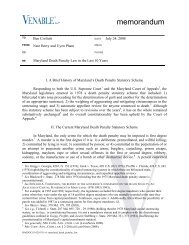Targeted Outreach - Governor's Office of Crime Control & Prevention ...
Targeted Outreach - Governor's Office of Crime Control & Prevention ...
Targeted Outreach - Governor's Office of Crime Control & Prevention ...
Create successful ePaper yourself
Turn your PDF publications into a flip-book with our unique Google optimized e-Paper software.
Youth’s Experiences at the Clubs 23<br />
any specific experience that would help explain participation<br />
rates for intervention target youth.<br />
Although we did not measure youth’s perceptions<br />
that the Club was instrumental in helping them get<br />
out <strong>of</strong> the gang or stay out <strong>of</strong> the gang and therefore<br />
cannot conclude that this would relate to retention<br />
rates, it is possible that intervention youth stay connected<br />
to the program primarily out <strong>of</strong> an interest in<br />
getting this type <strong>of</strong> help.<br />
We asked the target youth whether they had a favorite<br />
adult or activity at the Club and whether they would<br />
continue to attend if that adult or activity were no<br />
longer present. Of those with a favorite adult at the<br />
Club (86 percent <strong>of</strong> prevention and 57 percent <strong>of</strong><br />
intervention youth), about one-fifth <strong>of</strong> both intervention<br />
and prevention youth indicated they would not<br />
come if their favorite adult left. In contrast, 12 percent<br />
<strong>of</strong> prevention, but 35 percent <strong>of</strong> intervention<br />
youth, would stop going if their favorite activity<br />
ended. Sports were cited as the favorite activity <strong>of</strong><br />
more than half the youth who would leave the program<br />
if their favorite activity ended. At follow-up, 16<br />
percent <strong>of</strong> prevention and 21 percent <strong>of</strong> intervention<br />
youth revealed that they do not plan to attend the<br />
Club in the future, primarily because they were either<br />
too busy (26 percent for prevention and 33 percent<br />
for intervention) or bored (18 percent and 25 percent<br />
for prevention and intervention, respectively).<br />
more adults at the Club know them well than did<br />
youth who do not plan to return to the Club. This<br />
was not true for intervention youth. Although survey<br />
data did not indicate what keeps an intervention<br />
youth attracted to the Club, it is likely that the program<br />
itself, along with instrumental help with jobs,<br />
substance use, tattoo removal, etc., may be the driving<br />
force that keeps these youth returning. Factors<br />
and examples are described more fully in Chapter V.<br />
This chapter shows only that youth are receiving supports<br />
critical to their healthy development as a result<br />
<strong>of</strong> involvement in the Club or program. In the next<br />
chapter, we take the analysis <strong>of</strong> the program a step<br />
further to see how participation in the program actually<br />
affects youth. Do youth who participate more<br />
<strong>of</strong>ten have more positive outcomes? Do they do better<br />
in school? Do they participate in fewer gang and<br />
delinquent activities? Do they find their way out <strong>of</strong> or<br />
stay out <strong>of</strong> gangs?<br />
Summary<br />
The GPTTO and GITTO approaches are succeeding<br />
in keeping high-risk youth involved. Presumably,<br />
through this involvement, target youth are getting<br />
many positive developmental supports. They feel supported<br />
by adults at the Club and have a sense <strong>of</strong><br />
belonging. To a lesser degree, they feel that the activities<br />
at the Club are interesting and challenging, and<br />
feel safer at the Clubs than they do at school.<br />
Providing these developmental supports may keep<br />
these youth involved in the Club. The data indicate<br />
that this may be true, especially for prevention youth.<br />
<strong>Prevention</strong> youth who planned to continue at the<br />
Club after one year <strong>of</strong> attending had significantly<br />
higher scores on developmental supports. They<br />
reported a stronger sense <strong>of</strong> belonging, more adult<br />
support, engaging in more challenging and interesting<br />
activities, a stronger sense <strong>of</strong> Club safety, and that


